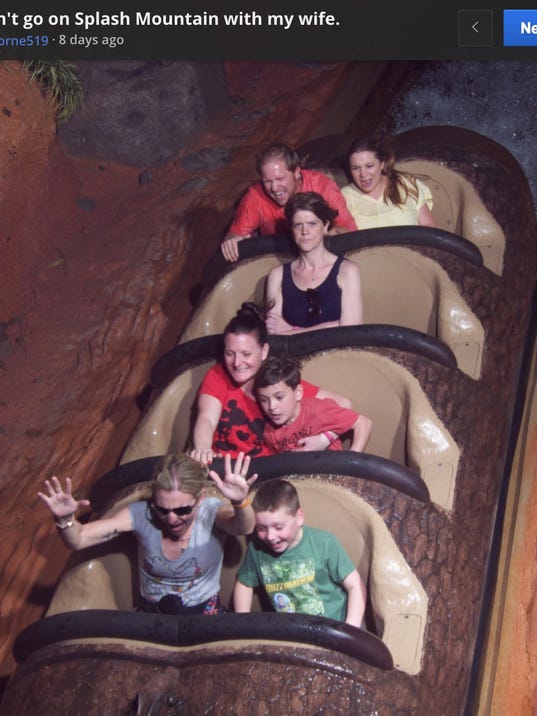VIDEO - What are memes - and how do they get kids in trouble?
Harvard revoked admissions for at least ten students after discovering they exchanged inappropriate memes in a Facebook chat. Elizabeth Keatinge (@elizkeatinge) has more. Buzz60

Jordan Alexander became the stuff that Internet–memes are made of, after he husband, Steven posted a photo of her frowning with her arms crossed on Disney’s popular Splash Mountain ride. (Photo: Steven Alexander)
SAN FRANCISCO — Memes are in the news because ten incoming Harvard freshmen had their acceptance revoked due to their posting of violent, racist and sexist memes on an offshoot of the Harvard-created Class of 2021 Facebook group.
These visual jokes have become ubiquitous online. Memes are used to satirize politics, popular culture and common experiences and are popular on platforms like Twitter, Reddit, Facebook and Tumblr.
Popular memes recent have included President Trump and Arab leaders with their hands on a glowing orb, a series of Obama-Biden leaving the White House Jokes and many, many memes involving cats.
For many young people today who grew up consuming media from the internet more than cable TV or newspapers, understanding, sharing and creating memes is second nature.
Youth-centric memes are concentrated in public groups — like those related to specific colleges — or even in private chats. And as memes grow more widespread and evolve in response to real-world events, old memes fall to the wayside and new ones gain traction. Throughout the process, memes help teens and young adults communicate, spread ideas and feel like they are a part of a national — and sometimes international — network.
Origins
The origins of one of the Internet's most popular joke formats may be surprising to many. It turns out the example of the would-be Harvard freshman example is less a veering away from a G-rated joke form than a return to its roots.
Over the last 40 years, the concept of memes that began with an Oxford professor then jumped to postings on violent, racist and offensive websites and has since morphed to the kind of cat jokes your aunt might send out to her choir email list.
The term was coined in 1976 by the British evolutionary biologist Richard Dawkins in his best-selling book The Selfish Gene. It described an idea, behavior or style that spread virally between humans within a culture. An infectious idea, Dawkins said, could leap from mind to mind much like a virus leaps from person to person.
Examples of memes are monotheism, the idea that the earth revolves around the sun or that diseases are caused by microbes and not evil spirits. These viral ideas spread from human to human and influenced culture, just as genes spread from human to human and affected the species, Dawkins wrote.
The concept of memes was embraced by thinkers and writers. By 1988 writer Howard Rheingold released a series of essays titled Excursions to the far side of the mind: A book of memes.
Related:
At least 10 who got into Harvard lose admission over offensive memes
Silver lining? 'Hamilton' controversy inspires new Biden memes
Pepe the Frog croaks: Cartoonist kills off character that became a hate symbol
The 'white guy blinking' meme, explained
By 1994, online observer and lawyer Mike Godwin wrote in Wired magazine about the ways the Internet was especially conducive to spreading these viral ideas. Godwin famously created one of earliest viral Internet memes, Godwin's Law of Nazi Analogies, which states "As an online discussion grows longer, the probability of a comparison involving Nazis or Hitler approaches one."
Beginning in the early 2000s one of the meme formats that has become most iconic – a picture with a line of text at the top and the bottom, in a font called Impact – first emerged.
Where they appeared is perhaps surprising. While images of cute babies, adorable animals and movie characters seem ubiquitous, the first memes became popular in the Internet’s unabashedly offensive troll culture, said Whitney Phillips, a professor of digital folklore at Mercer University in Georgia who studies memes.
Racist, sexist and violent memes in the new format found a potent breeding ground on 4chan, a web discussion board that included a large array of offensive material.
The format, minus the offensive content, made the leap into popular culture beginning around 2009, much to the anger of the trolls who had created it.
“There was quite a lot of resentment that their highly esoteric, highly offensive and highly specific form had become this thing your uncle does on Facebook,” said Phillips. She and co-author Ryan Milner have a book coming out next week on memes and online expression called The Ambivalent Internet.
While many memes shared online are light-hearted, they can also involve inappropriate and often taboo subjects. In this way, they are much like off-color jokes that might have been told after a quick look around to see who was within earshot. Only now they're posted online in forums.
This gives the illusion that they're private "but of course, nothing is private online,” said author Rheingold. "Isn’t it amazing that they were smart enough to get into Harvard and not smart enough to know this?" he asked.
Read or Share this story: https://usat.ly/2sOUMtW